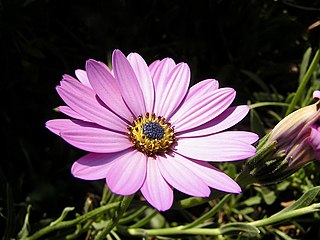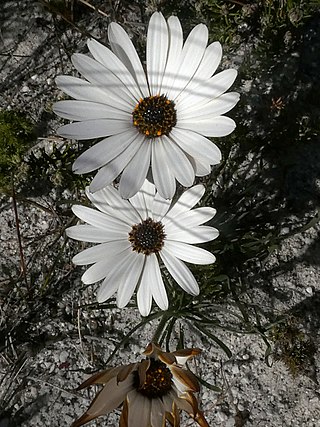
Osteospermum, is a genus of flowering plants belonging to the Calenduleae, one of the smaller tribes of the sunflower/daisy family Asteraceae. They are known as the daisybushes or African daisies. Its species have been given several common names, including African daisy, South African daisy, Cape daisy and blue-eyed daisy.

Dimorphotheca ecklonis, also known as Cape Marguerite, African daisy, Van Staden's River daisy, Sundays River daisy, white daisy bush, blue-and-white daisy bush, star of the veldt, Kaapse magriet, jakkalsbos, Vanstadensrivier madeliefie, or Sondagsrivier madeliefie is a perennial ornamental plant that is native to South Africa. It features white ray florets and a dark blue centre and is part of the Asteraceae family. The species is named after Christian Friedrich Ecklon, a Danish botanical collector who explored the flora of the Cape in the early 1800s. It is regarded as an invasive plant in parts of Australia, particularly Victoria and Western Australia.

Dimorphotheca is a genus of plants in the family Asteraceae, native to southern Africa. is one of eight genera of the Calenduleae, with a centre of diversity in Southern Africa. Species are native to Botswana, Eswatini, Lesotho, Namibia, South Africa, and Zimbabwe. Some species can hybridize with Osteospermum, and crosses are sold as cultivated ornamentals. The name "Dimorphotheca" comes from the Greek "Dis" "Morphe" and "Theka", meaning "two shaped receptacle", referring to the dimorphic cypselae, a trait inherent to members of the Calenduleae. Plants of this genus usually have bisexual flowers.

Drosera cistiflora, also called the poppy-flowered sundew, is a carnivorous species in the sundew family, known for its unusually large flowers. It is native to Southern Africa.

Dimorphotheca pluvialis, common names white African daisy, Cape marigold, weather prophet, Cape rain-daisy, ox-eye daisy, Cape daisy or rain daisy, is a plant species native to South Africa and Namibia. It is sparingly naturalized in scattered locations in California.
Terence Macleane Salter was a British/South African plant collector and botanist. Among the plant taxa named in his honor are the genus Saltera (Penaeaceae) and the orchid Disa salteri.
Felicia annectens is an annual plant of up to about 25 cm (10 in) high, that is assigned to the family Asteraceae. The lower leaves are opposite and the higher leaves alternate. The bloated involucre consists of very broad, hairless bracts. These protect up to ten, short, bluish ray florets that encircle yellow, partly sterile disc florets. The heads sit individually on top of up to 6 cm long stalks. The species was considered extinct after no observations were made after 1915, but was rediscovered in the 21st century. It occurs in the Western Cape province of South Africa.
Othonna purpurascens is a species of flowering plant in the family Asteraceae. It is endemic to South Africa.

Hymenolepis indivisa is a species of flowering plant in the family Asteraceae. It is endemic to South Africa.

Dimorphotheca acutifolia is a plant belonging to the genus Dimorphotheca. The species is native to the Eastern and Western Cape Provinces.

Dimorphotheca barberae is a species of flowering plant in the family Asteraceae. The species is endemic to the Eastern Cape in South Africa.

Dimorphotheca chrysanthemifolia is a plant belonging to the genus Dimorphotheca. The species is endemic to the Western Cape.

Dimorphotheca montana is a plant belonging to the genus Dimorphotheca. The species is endemic to the Western Cape.

Dimorphotheca nudicaulis is a plant that belongs to the genus Dimorphotheca. The species is endemic to the Northern Cape and the Western Cape.
Dimorphotheca polyptera is a plant belonging to the genus Dimorphotheca. The species is native to the Northern Cape, Western Cape and Namibia.
Aptosimum neglectum is a species of plant in the genus Aptosimum endemic to the Northern Cape Province of South Africa.

Agapanthus caulescens, the stem agapanthus, is a species of flowering plant in the family Amaryllidaceae. Its three subspecies are found in Eswatini and eastern South Africa.

Agapanthus campanulatus, the bell agapanthus, is a species of flowering plant in the family Amaryllidaceae endemic to the Drakensberg in Southern Africa.

Dimorphotheca tragus is a plant that belongs to the genus Dimorphotheca. The species is endemic to the Northern Cape and the Western Cape.

Dimorphotheca venusta is a plant belonging to the genus Dimorphotheca. The species is endemic to the Western Cape and occurs in the Wemmershoek, Du Toitskloof and Hexrivier mountains at altitudes of 600 - 1,800 m. The plant is considered rare. The species was described by Nils Tycho Norlindh in 1980.















